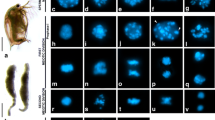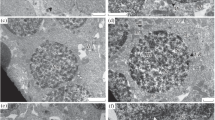Abstract
In this article, we describe meiosis-I in spermatocytes of the free-living freshwater flatworm Mesostoma ehrenbergii. The original observations of Oakley (1983, 1985) and Fuge (Eur J Cell Biol 44:294–298, 1987, Cell Motil Cytoskeleton 13:212–220, 1989, Protoplasma 160:39–48, 1991), the first to describe these cells, challenge our understanding of cell division, and we have expanded on these descriptions with the aim of laying the framework for further experimental work. These cells contain three bivalents and four univalent chromosomes (two pairs). Bivalent kinetochores oscillate vigorously and regularly throughout prometaphase, for up to several hours, until anaphase. Anaphase onset usually begins in the middle of the kinetochore oscillation cycle. Precocious cleavage furrows form at the start of prometaphase, ingress and then remain arrested until the end of anaphase. The four univalents do not pair, yet by anaphase there is one of each kind at each pole, an example of “distance segregation” (Hughes-Schrader in Chromosoma 27:109–129, 1969). Until proper segregation is achieved, univalents move between spindle poles up to seven times in an individual cell; they move with velocities averaging 9 μm/min, which is faster than the oscillatory motions of the bivalent kinetochores (5–6 μm/min), and much faster than the anaphase movements of the segregating half-bivalents (1 μm/min). Bipolar bivalents periodically reorient, most often resulting in the partner kinetochores exchanging poles. We suggest that the large numbers of inter-polar movements of univalents, and the reorientations of bivalents that lead to partners exchanging poles, might be because there is non-random segregation of chromosomes, as in some other cell types.














Similar content being viewed by others
References
Aist JR, Bayles CJ (1988) Video motion analysis of mitotic events in living cells of the fungus Fusarium solani. Cell Motil Cytoskeleton 9:325–336
Ault JG, DeMarco AJ, Salmon ED, Rieder CL (1991) Studies on the ejection properties of asters: astral microtubule turnover influences the oscillatory behaviour and positioning of mono-oriented chromosomes. J Cell Sci 99:701–710
Bajer AS (1982) Functional autonomy of monopolar spindle and evidence for oscillatory movement in mitosis. J Cell Biol 93:33–48
Camenzind R, Nicklas RB (1968) The non-random segregation in spermatocytes of Gryllotalpa hexadactyla. A micromanipulation analysis. Chromosoma 24:324–335
Cameron LA, Yang G, Cimini D, Canman JC, Kisurina-Evgenieva O, Khodjakov A, Danuser G, Salmon ED (2006) Kinesin 5-independent poleward flux of kinetochore microtubules in PtK1 cells. J Cell Biol 173:173–179
Campas O, Sens P (2006) Chromosome oscillations in mitosis. Phys Rev Lett 97:1–4
Carlson JG (1977) Anaphase chromosome movement in the unequally dividing grasshopper neuroblast and its relation to anaphases of other cells. Chromosoma 64:191–206
Cassimeris L, Rieder CL, Salmon ED (1994) Microtubule assembly and kinetochore directional instability in vertebrate monopolar spindles: implications for the mechanism of chromosome congression. J Cell Sci 107:285–297
Civelekoglu-Scholey G, Sharp DJ, Mogilner A, Scholey JM (2006) Model of chromosome motility in Drosophila embryos: adaptation of a general mechanism for rapid mitosis. Biophys J 90:3966–3986
Civelekoglu-Scholey G, He B, Shen M, Wan X, Roscioli E, Bowden B, Cimini D (2013) Dynamic bonds and polar ejection force distribution explain kinetochore oscillations in PtK1 cells. J Cell Biol 201:577–593
Dietz R (1956) Die Spermatocytenteilungen der Tipuliden. II. Graphische analyse der chromosomenbewegung während der prometaphase I im leben. Chromosoma 8:183–211
Ferraro-Gideon J, Sheykhani R, Zhu Q, Duquette ML, Berns MW, Forer A (2013) Measurements of forces produced by the mitotic spindle using optical tweezers. Mol Biol Cell 24:1375–1386
Forer A, Koch C (1973) Influence of autosome movements and of sex chromosome movements on sex-chromosome segregation in crane fly spermatocytes. Chromosoma 40:417–442
Forer A, Pickett-Heaps JD (2005) Fibrin clots keep non-adhering living cells in place on glass for perfusion or fixation. Cell Biol Int 29:721–730
Forer A, Pickett-Heaps JD (2010) Precocious (pre-anaphase) cleavage furrows in Mesostoma spermatocytes. Eur J Cell Biol 89:607–618
Forer A, Spurck T, Pickett-Heaps JD, Wilson PJ (2003) Structure of kinetochore fibres in crane-fly spermatocytes after irradiation with an ultraviolet microbeam: neither microtubules nor actin filaments remain in the irradiated region. Cell Motil Cytoskeleton 56:173–192
Forer A, Pickett-Heaps JD, Spurck T (2008) What generates flux of tubulin in kinetochore microtubules? Protoplasma 232:137–141
Forer A, Ferraro-Gideon J, Berns MW (2013) Distance segregation of sex chromosomes in crane-fly spermatocytes studied using laser microbeam irradiations. Protoplasma. doi:10.1007/s00709-013-0480-4
Fuge H (1987) Oscillatory movements of bipolar-oriented bivalent kinetochores and spindle forces in male meiosis of Mesostoma ehrenbergii. Eur J Cell Biol 44:294–298
Fuge H (1989) Rapid kinetochore movements in Mesostoma ehrenbergii spermatocytes: action of antagonistic chromosome fibre. Cell Motil Cytoskeleton 13:212–220
Fuge H (1991) Morphological aspects of chromosome spindle fibres in Mesostoma: “microtubular fir-tree” structures and microtubule association with kinetochores and chromatin. Protoplasma 160:39–48
Gerbi SA (1986) Unusual chromosome movements in sciarid flies. Results Probl Cell Differ 13:71–104
Hebert PDN, Beaton MJ (1990) Breeding systems and genome size of the rhabdocoel turbellaria Mesostoma ehrenbergii. Genome 33:719–724
Hoang C, Ferraro-Gideon J, Gauthier K, Forer A (2013) Methods for rearing Mesostoma ehrenbergii in the laboratory for cell biology experiments, including identification of factors that influence production of different egg types. Cell Biol Int. doi:10.1002/cbin.10129
Hughes-Schrader S (1969) Distance segregation and compound sex chromosomes in Mantispids (Neuroptera: Mantispidae). Chromosoma 27:109–129
Husted L, Ruebush TK (1940) A comparative cytological and morphological study of Mesostoma ehrenbergii ehrenbergii and Mesostoma ehrenbergii wardii. J Morphol 67:387–410
Husted L, Ferguson FF, Strewalt MA (1939) Chromosome association in Mesostoma ehrenbergii (Focke) Schmidt. Amer Naturalist 73:180–184
Jaqaman K, King EM, Amaro AC, Winter JR, Dorn JF, Elliot HL, Mchedlishvili N, McClelland SE, Porter IA, Posch M et al (2010) Kinteochore alignment within the metaphase plate is regulated by centromere stiffness and microtubule depolymerise. J Cell Biol 188:665–679
Johansen KM, Forer A, Yao C, Girton J, Johansen J (2011) Do nuclear envelope and intranuclear proteins reorganize during mitosis to form an elastic, hydrogel-like spindle matrix? Chromosome Res 19:345–365
Katajima TS, Ohsugi M, Ellenberg J (2011) Complete kinetochore tracking reveals error-prone homologous chromosome biorientation in mammalian oocytes. Cell 146:568–581
Ke K, Cheng J, Hunt AJ (2009) The distribution of polar ejection forces determines the amplitude of chromosome directional instability. Curr Biol 19:807–815
Khodjakov A, Rieder CL (1996) Kinetochores moving away from their associated pole do not exert a significant pushing force on the chromosome. J Cell Biol 135:315–327
Khodjakov A, Cole RW, McEwan BF, Buttle KF, Rieder CL (1997) Chromosome fragments possessing only one kinetochore can congress to the spindle equator. J Cell Bio 136:229–240
Liu J, Desai A, Onuchic JN, Hwa T (2007) A mechanobiochemical mechanism for monooriented chromosome oscillation in mitosis. PNAS 104:16104–16109
Nicklas RB (1972) Chromosome micromanipulation IV. Polarized motions within the spindle and models for mitosis. Chromosoma 39:1–26
Nicklas RB, Staehly CA (1967) Chromosome micromanipulation. I. The mechanics of chromosome attachment to the spindle. Chromosoma 21:1–16
Nur U (1982) Destruction of specific heterochromatic chromosomes during spermatogenesis in the Comstockiella chromosome system (Coccoidea: Homoptera). Chromosoma (Berl) 85:519–530
Oakley HA (1983) Male meiosis in Mesostoma ehrenbergii ehrenbergii. Kew Chromosome Conference II Editors PE Brandham, MD Bennett. George Allen and Unwin, London (Boston, Sydney) pp 195–199
Oakley HA (1985) Meiosis in Mesostoma ehrenbergii ehrenbergii (Turbellaria, Rhabdocoela) III. Univalent chromosome segregation during the first meiotic division in spermatocytes. Chromosoma 91:95–100
Pickett-Heap JD, Tippit DH (1980) Light and electron microscopic oberservations on cell division in two large pinnate diatoms, Hantzschia and Nitzschia. I. Mitosis in vivo. Eur J Cell Biol 21:1–11
Pickett-Heaps JD, Forer A (2009) Mitosis: spindle evolution and the matrix model. Protoplasma 235:91–99
Pickett-Heaps JD, Tippit DH, Andreozzi JA (1979) Cell division in the pinnate diatom Pinnularia. V—Observations on live cells. Biol Cell 35:295–304
Riche S, Zouak M, Argoul F, Arneodo A, Pecreaux J, Delattre M (2013) Evolutionary comparisons reveal a positional switch for spindle pole oscillations in Caenorhabditis embryos. J Cell Biol 201:653–662
Rieder CL, Salmon ED (1994) Motile kinetochores and polar ejection forces dictate chromosome position on the vertebrate mitotic spindle. J Cell Biol 124:223–233
Schrader F (1921) The chromosomes of Pseudococcus nipae. Biol Bull 40:259–270
Sharp DJ, Ross JL (2012) Microtubule-severing enzymes at the cutting edge. J Cell Sci 125:2561–2569
Sheykhani R, Shirodkar P, Forer A (2013) The role of myosin phosphorylation in anaphase chromosome movement. Eur J Cell Biol 92:175–186
Skibbens RV, Skeen VP, Salmon ED (1993) Directional instability of kinetochore motility during chromosome congression and segregation in mitotic newt lung cells: a push–pull mechanism. J Cell Biol 122:859–875
Skibbens RV, Rieder CL, Salmon ED (1995) Kinetochore motility after severing between sister centromeres using laser microsurgery: evidence that kinetochore directional instability and position is regulated by tension. J Cell Sci 108:2537–2548
Wan X, Cimini D, Cameron LA, Salmon ED (2012) The coupling between sister kinetochore directional instability and oscillation in centromere stretch in metaphase PtK1 cells. Mol Biol Cell 23:1035–1046
Wong R, Forer A (2003) Backward chromosome movement in crane-fly spermatocytes after UV microbeam irradiation of the interzone and a kinetochore. Cell Biol Int 28:293–298
Acknowledgements
This work was supported by grants from the Canadian Natural Sciences and Engineering Council to A.F.
Conflict of interest
None of the authors have any conflict of interest.
Author information
Authors and Affiliations
Corresponding author
Additional information
Handling Editor: Patricia Wadsworth
Electronic supplementary material
Below is the link to the electronic supplementary material.
(AVI 19626 kb)
(AVI 35390 kb)
(AVI 4326 kb)
Rights and permissions
About this article
Cite this article
Ferraro-Gideon, J., Hoang, C. & Forer, A. Meiosis-I in Mesostoma ehrenbergii spermatocytes includes distance segregation and inter-polar movements of univalents, and vigorous oscillations of bivalents. Protoplasma 251, 127–143 (2014). https://doi.org/10.1007/s00709-013-0532-9
Received:
Accepted:
Published:
Issue Date:
DOI: https://doi.org/10.1007/s00709-013-0532-9




